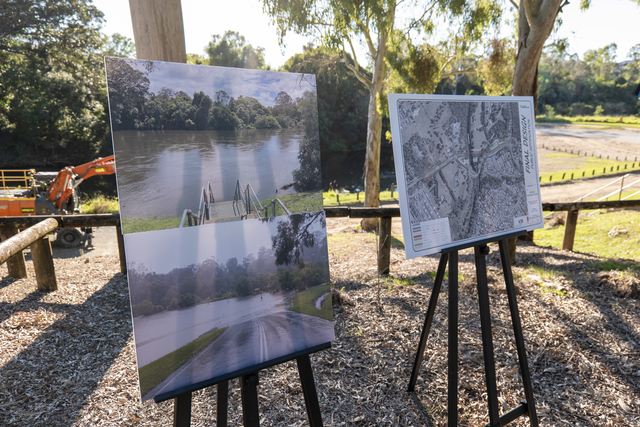The old adage ‘necessity is the mother of invention’ certainly holds true at Liverpool Plains Shire Council and the Tr@ceR EDMS program is testament to this. Council had been considering the idea of purchasing an off the shelf electronic document management system (EDMS) for ten years or more without success.
The Local Government EDMS programs available at the time were both expensive and very demanding on resources to implement and maintain, particularly for small to medium size rural councils.
The availability of funds to purchase an EDMS were very limited as monies were needed for projects, such as the repair of ailing road infrastructure, building maintenance and other Council services. So, in June 2005, a team of dedicated Council staff set out to build an EDMS for Liverpool Plains Shire. After 12 months of painstaking research, development and testing, the team had successfully created an electronic document management system called Tr@ceR – a program that would change the way staff deal with their correspondence and customer action requests forever.
Tr@ceR EDMS is a simple to use program for the entire organisation big or small. It is a user friendly program that automates the former manual recording, storage and retrieval process for all documents.
The electronic documents are delivered by two methods – either to the user’s desktop, or electronically via web SMS messaging to staff mobile phones.
User procedures for classifying, tasking, searching, letter creation and customer action requests are straightforward and easy to follow.
One distinct feature of Tr@ceR that sets it apart from other EDMS programs is the classifying procedure. Tr@ceR does not require the end user to classify their documents into the system, this is completed by the trained records personnel. This provides for a more consistent approach to classifying and allows the end users such as engineers and planners to get on with their own work.
The program has also been a change agent for Council, lifting the level of customer service and the performance of staff in every layer of the organisation.
Tr@ceR reporting tools are excellent for benchmarking staff and organisational performance in reply to correspondence and completion of Customer Action Requests.
Liverpool Plains Shire Council has received many awards for its Tr@ceR EDMS product including:
- Australian Government – Local Government National Award for
Innovation 2007 (small Council under 15,000 ratepayers) - Australian Government – Local Government National Award for
Innovation 2007 Category Winner - LGMA Management Excellence Awards 2008 –
Commendation - Northern Inland Innovation Award 2007.
After 12 months of successful operation, Council decided the Tr@ceR EDMS program should be marketed and sold to other Local Governments. The first Council to purchase the Tr@ceR program was Ravensthorpe Shire Council, located 530 kilometres southeast of Perth. Tr@ceR has now been in operation there for the past two years.
Ravensthorpe Shire Finance and Administration Manager, Evelyn Arnold, said while Ravensthorpe is a small shire, it has a large amount of incoming and outgoing paperwork that needs to be managed and tracked.
“Since implementing the Tr@ceR system, we have been able to keep better track of our correspondence, and we also have a more certain filing system,” Evelyn Arnold said.
She said Tr@ceR assists with the turnover of staff that many smaller shires experience, as someone not involved in the initial correspondence can still find the history of a document and ascertain what action has been taken to date.
“In addition, each new staff member tends to bring with them a different filing technique,” Evelyn Arnold said. “But with Tr@ceR, we have a standardised system that is intuitive, easy to use and quick to get people trained up and running in.”
In June 2009 Gloucester Shire Council located in the northern extremities of the Hunter region of New South Wales, commenced operating Tr@ceR.
General Manager, Allan Young, said Council chose Tr@cer for its simplicity.
“It is a product designed by Local Government, for Local Government,” he said. “Other products available on the market are basically record management systems that have been adjusted for use by Local Government.”
Allan Young said a key benefit on going electronic is that staff gain immediate access to records, and are able to research topics of interest or correspondence from their own desktop.
“There is also increased traceability, with all correspondence and actions able to be tracked, unlike paper based systems where the paper trail can easily be lost,” he said.
When compared to other electronic document management systems, Allan Young said Tr@cer requires less staff input and is less hardware intensive.
Gilgandra Shire Council in NSW became the third Council to install Tr@ceR in July 2009. Gilgandra chose to replace its existing EDMS program with Tr@ceR, as it offered a cheaper and more user friendly alternative that required less intervention from end users and this was a big efficiency gain for Council.
Gilgandra Shire’s Director of Corporate and Business Services Neil Alchin commented that a records system developed by Local Government for Local Government brought with it the advantages of understanding what both internal and external customers require.
“We are very happy with Tr@ceR and in particular the opportunity to work with a small but professional team that has a real understanding of Councils requirements,” he said. “We have been very impressed with the level of support provided along with the speed with which enhancements to the system are considered and implemented where appropriate”.
Other councils that have purchased Tr@ceR for installation this financial year include Brewarrina Shire Council (NSW), Junee Shire Council (NSW) and Yass Valley Shire Council (NSW).
The IT staff at Liverpool Plains Shire Council are currently reviewing the Tr@ceR EDMS program. A new version in ASP.NET programming language is under development and will be released before the end of the year.
The new version will streamline many of the end user processes and will make the program more user friendly and functional, easier to install, and will provide browser based technology.
Council staff have also embarked on the development of other, much needed modules for Local Government including OH&S, human resources and Council business papers. These modules when complete will be marketed as separate programs.







